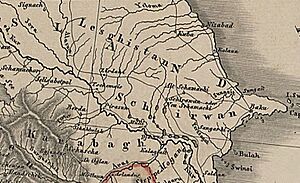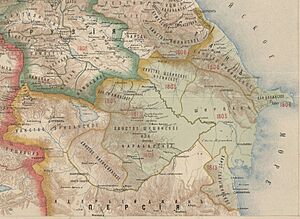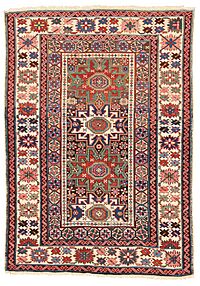Lezgins facts for kids
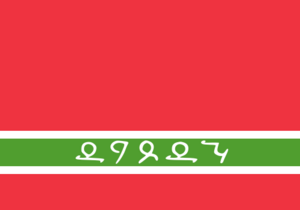
Flag used by the Lezgin people
|
|
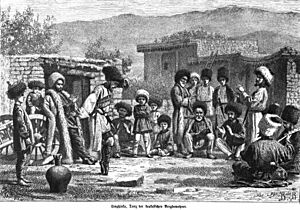 |
|
| Total population | |
|---|---|
| <1.2 million | |
| Regions with significant populations | |
|
488,608 |
| 167,570 | |
| Languages | |
| Lezgin | |
| Religion | |
| Sunni Islam, minority Shia Islam | |
| Related ethnic groups | |
| Other Northeast Caucasian peoples, especially Aghuls, Tsakhurs, Tabasarans, Udis, and Rutuls | |
The Lezgins (Lezgian: Лезгияр) are a group of people who live mostly in southern Dagestan, a part of Russia, and northeastern Azerbaijan. They speak the Lezgin language. Their society values equality and individual freedom. Lezgin communities are built around groups of families called djamaat (unions of clans) and many independent local clans called syhils.
Throughout history, the Lezgin lands have faced many invaders. Because their land is isolated and important to outsiders, the Lezgin people have developed a strong sense of community. They also have a special code of honor called Lezgiwal. This code guides their moral behavior, encourages generosity, and teaches them to protect the honor of women. It has been passed down through generations.
Contents
What Does the Name "Lezgin" Mean?
The Lezgin people's national animal is the eagle. Some people believe the name Lezgi comes from Lek, which is the Lezgin word for "eagle."
Other ideas suggest that Lezgi comes from older names like Legi or Lakzi. Ancient Greek historians, such as Herodotus, called people living in this area Legoi. Arab historians from the 9th and 10th centuries mentioned a kingdom called Lakz in southern Dagestan. They called its people Lakzams, which meant Lezgins.
Before the Russian Revolution in 1917, the name "Lezgin" was sometimes used for many different groups living in what is now Dagestan.
A Look at Lezgin History
Around 400 BC, many tribes who spoke Lezgic languages joined together. They formed a group of 26 tribes in a state called Caucasian Albania in the Eastern Caucasus. This state became part of the Persian Achaemenid Empire in 513 BC.
Lezgic-speaking tribes fought alongside the Persians against Alexander the Great in the battle of Gaugamela. Later, under the Parthian Empire, Persian culture and politics became very important in the region.
In 252–253 AD, the Sassanid Persian Empire took control from the Parthians. Caucasian Albania became a state that had to obey the Sassanids. The Sassanids then ruled the area for many centuries until the Arab invasions.
Lezgins first learned about Islam around the 8th century. However, most Lezgins kept their old beliefs until the 15th century. At that time, Muslim influence grew stronger, with traders from Persia and pressure from the Golden Horde in the north.
In the early 1500s, the Persian Safavids took control of much of Dagestan. They ruled for centuries. During the Ottoman–Safavid War, the Ottomans briefly took over, but the Safavids regained control under King Abbas I.
A famous Lezgin from this time was Fath-Ali Khan Daghestani. He was a top advisor to the Safavid king from 1716 to 1720. In 1721, Lezgins attacked and looted the city of Shamakhi.
In the 18th century, Persia regained full control over the Caucasus under Nader Shah. After Nader's death, the area split into many smaller states called khanates. Some Lezgins lived in the Kuba Khanate and the Derbent Khanate. Many Lezgins also formed "free societies" in their mountain villages.
In 1813, Russia gained control over southern Dagestan and parts of Azerbaijan through the Treaty of Gulistan. The 1828 Treaty of Turkmenchay made Russia's control even stronger. Many Lezgins in Dagestan fought against the Russians in the Caucasian War. They joined Imam Shamil, who fought Russia for 25 years. Russia finally took full control of Dagestan and the Lezgins after Shamil's defeat in 1859.
Lezgin Culture and Traditions
Lezgin culture is a special mix of old customs. The eagle, or Lek, is their national animal and a symbol of freedom. Many Lezgin heroes, like Abrek Kiri Buba, fought for independence. Lezgins value equality and individual choice.
Their society is built around djamaat (unions of clans) and about 200-300 syhils (clans). Each syhil comes from a common ancestor and often has its own village and mountain. Syhils are also divided into smaller family groups called miresar.
Lezgin villages are called "hur." Each village has different sections, often with one syhil living in each section. Villages also have a Kim, which is a meeting place for men to discuss important community matters.
Lezgiwal: The Code of Honor
Lezgiwal (Lezgian: Лезгивал) is an unwritten code of honor for the Lezgin people. It's a set of ethical rules that guides their lives from childhood. Lezgiwal teaches moral behavior, generosity, and the importance of protecting the honor of women. The legendary hero Abrek Kiri Buba once said, "Better a knife in the chest than honor in the dirt." This shows how important honor is in Lezgiwal.
Religion and Beliefs
Most Lezgins are Muslims, like many other Northeast Caucasian people. However, their old traditions are also very strong. Over time, especially during the Soviet era, religious practices were sometimes limited. Today, cultural traditions often play a bigger role than strict religious rules.
Lezgins celebrate Yaran Suvar, an ancient festival from before Islam. Some also celebrate Muslim holidays like Ramadan and Eid al-Fitr.
Lezgin Language and Stories
The Lezgin language is part of the Lezgic group of the Northeast Caucasian language family. This group also includes languages like Aghul, Rutul, and Tabasaran.
Lezgin has three main dialects: Kurin, Akhti, and Kuba. The Kurin dialect is the most common. It is spoken in most Lezgin areas in Dagestan. The Kuba dialect is spoken in northern Azerbaijan.
Dances and Music
The Lezgin dance, known as Lezginka, is popular among many people in the Caucasus. In this dance, the man moves like an "eagle," changing between slow and fast steps. He often dances on his toes, throwing his hands out. The woman moves like a "swan," with graceful poses and smooth hand movements. She speeds up her dance after the man. The dance is named after the Lezgin word for eagle, "Lek."
Lezgins enjoy epic songs about wars and heroes. Famous songs include "Shamil atana" (about Imam Shamil) and "Kiri Buba" (about a Lezgin hero). The first Lezgin theater started in 1906 in the village of Akhty. Today, there are Lezgin theaters in Dagestan and Azerbaijan.
Where Lezgins Live
Lezgins live in a specific area that crosses the border between southern Dagestan in Russia and northern Azerbaijan. This area has two main types of land: high, rugged mountains and lower foothills.
Most of the Lezgin land is in the mountains, with peaks over 3,500 meters high. There are deep canyons and gorges formed by rivers. Summers in the mountains are hot and dry, and winters are cold and windy. In this area, Lezgins traditionally raised animals like sheep and goats, and worked in crafts.
In the eastern part of the Lezgin territory, the mountains meet the narrow plain near the Caspian Sea. This foothill region has mild, dry winters and hot, dry summers. Here, people also raised animals and made crafts, but they also farmed near the rivers.
Most Lezgins live in Azerbaijan and Russia (Dagestan). The total number is thought to be around 700,000. About 474,000 live in Russia. In Azerbaijan, the government counts about 180,300 Lezgins. However, Lezgin groups believe the number is much higher, possibly 600,000 to 900,000. This difference might be because some Lezgins in Azerbaijan say they are Azeri to avoid problems with jobs or education.
Lezgins in Azerbaijan
Lezgins in Azerbaijan are generally well-integrated into society. Mixed marriages between Lezgins and Azeris are common. Lezgins in Azerbaijan also tend to have a higher level of education than those in Dagestan.
In 1992, a Lezgin group called Sadval was formed to support Lezgin rights. Sadval wanted to change the border between Russia and Azerbaijan to create a single Lezgin state. In Azerbaijan, a group called Samur was formed. It asked for more cultural freedom for Lezgins in Azerbaijan.
Lezgins often faced unemployment and a lack of land. When the war in Chechnya started in 1994, the border between Russia and Azerbaijan was closed. This meant Lezgins were separated by an international border for the first time.
By the late 1990s, the Lezgin movement in Azerbaijan became less active. Sadval was banned after being accused of involvement in a bombing. Lezgins also expressed concern about not having enough representatives in the Azerbaijani Parliament. They feel they face discrimination and are sometimes pressured to identify as Azeri.
Lezgin is taught in some areas where many Lezgins live, but there are not many teaching materials. Lezgin newspapers are available, but people worry about their rich oral traditions disappearing. Lezgin TV is only available from Russia.
Lezgins in Dagestan
Reports suggest that Lezgins in Dagestan face high unemployment rates. This might be one reason why some in the Sadval movement have asked for the Russian-Azerbaijani border to be redrawn. They want Lezgin areas of southern Dagestan to be part of Azerbaijan.
In 1999, another group called the Federal Lezgin National Cultural Autonomy was created. This group supports cultural freedom for Lezgins.
Lezgin Ancestry
Modern Lezgins speak Northeast Caucasian languages. These languages have been spoken in the region for a very long time, even before Indo-European languages arrived. Lezgins are closely related to the Aghuls of southern Dagestan. They are also related, though less closely, to the Tsakhurs, Rutuls, and Tabasarans. Other related groups include the Jek, Kryts, and Khinalug people in northern Azerbaijan. All these groups, including the Lezgins, form the Samur branch of the native Lezgic peoples.
Scientists believe Lezgins are partly descended from people who lived in southern Dagestan during the Bronze Age. DNA evidence also shows that there was some mixing with people from Central Asia over the last 4,000 years.
Famous Lezgin People
- Hadji Dawud (1680–c. 1736) was a Lezgin military leader and religious figure. He led the fight against the Persian Empire in the Caucasus in the early 1700s. He is seen as a hero for the Lezgin and Dagestan people.
- Suleyman Kerimov (born 1966) is a Russian businessman and politician.
- Nazim Huseynov (born 1969) is a judoka who won a gold medal at the 1992 Summer Olympics.
- Ruslan Gurbanov (born 1991) is a footballer.
- Tavakkul Aslanov is a chef and host of the Wilderness Cooking YouTube Channel.
- Ikram Aliskerov (born 1992) is a four-time world champion in combat sambo and an MMA fighter.
See Also
- Nader's Dagestan campaign
- Lezginka
- Lezgin language
- Lezgistan
- North Caucasian people
- Northeast Caucasian people


